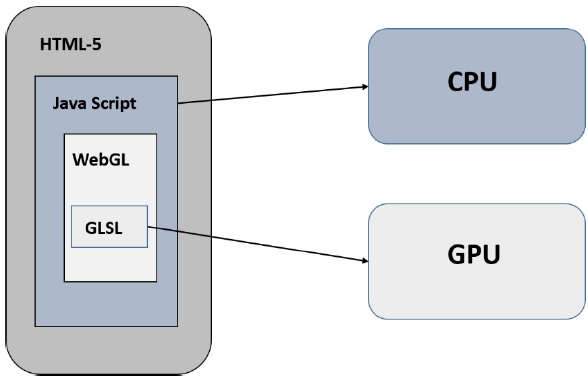We have discussed the basics of WebGL and the WebGL pipeline (a
procedure followed to render Graphics applications). In this chapter, we
are going to take a sample application to create a triangle using WebGL
and observe the steps followed in the application.

We follow five sequential steps to draw a simple triangle using WebGL. These steps are exaplained as follows −
Step 1 − Prepare the canvas and get WebGL rendering context
We get the current HTML canvas object and obtain its WebGL rendering context.
Step 2 − Define the geometry and store it in buffer objects
We define the attributes of the geometry such as vertices, indices, color, etc., and store them in the JavaScript arrays. Then, we create one or more buffer objects and pass the arrays containing the data to the respective buffer object. In the example, we store the vertices of the triangle in a JavaScript array and pass this array to a vertex buffer object.
Step 3 − Create and compile Shader programs
We write vertex shader and fragment shader programs, compile them, and create a combined program by linking these two programs.
Step 4 − Associate the shader programs with buffer objects
We associate the buffer objects and the combined shader program.
Step 5 − Drawing the required object (triangle)
This step includes operations such as clearing the color, clearing the buffer bit, enabling the depth test, setting the view port, etc. Finally, you need to draw the required primitives using one of the methods − drawArrays() or drawElements().
All these steps are explained further in this tutorial.
Structure of WebGL Application
WebGL application code is a combination of JavaScript and OpenGL Shader Language.- JavaScript is required to communicate with the CPU
- OpenGL Shader Language is required to communicate with the GPU.

Sample Application
Let us now take a simple example to learn how to use WebGL to draw a simple triangle with 2D coordinates.<!doctype html> <html> <body> <canvas width = "300" height = "300" id = "my_Canvas"></canvas> <script> /* Step1: Prepare the canvas and get WebGL context */ var canvas = document.getElementById('my_Canvas'); var gl = canvas.getContext('experimental-webgl'); /* Step2: Define the geometry and store it in buffer objects */ var vertices = [-0.5, 0.5, -0.5, -0.5, 0.0, -0.5,]; // Create a new buffer object var vertex_buffer = gl.createBuffer(); // Bind an empty array buffer to it gl.bindBuffer(gl.ARRAY_BUFFER, vertex_buffer); // Pass the vertices data to the buffer gl.bufferData(gl.ARRAY_BUFFER, new Float32Array(vertices), gl.STATIC_DRAW); // Unbind the buffer gl.bindBuffer(gl.ARRAY_BUFFER, null); /* Step3: Create and compile Shader programs */ // Vertex shader source code var vertCode = 'attribute vec2 coordinates;' + 'void main(void) {' + ' gl_Position = vec4(coordinates,0.0, 1.0);' + '}'; //Create a vertex shader object var vertShader = gl.createShader(gl.VERTEX_SHADER); //Attach vertex shader source code gl.shaderSource(vertShader, vertCode); //Compile the vertex shader gl.compileShader(vertShader); //Fragment shader source code var fragCode = 'void main(void) {' + 'gl_FragColor = vec4(0.0, 0.0, 0.0, 0.1);' + '}'; // Create fragment shader object var fragShader = gl.createShader(gl.FRAGMENT_SHADER); // Attach fragment shader source code gl.shaderSource(fragShader, fragCode); // Compile the fragment shader gl.compileShader(fragShader); // Create a shader program object to store combined shader program var shaderProgram = gl.createProgram(); // Attach a vertex shader gl.attachShader(shaderProgram, vertShader); // Attach a fragment shader gl.attachShader(shaderProgram, fragShader); // Link both programs gl.linkProgram(shaderProgram); // Use the combined shader program object gl.useProgram(shaderProgram); /* Step 4: Associate the shader programs to buffer objects */ //Bind vertex buffer object gl.bindBuffer(gl.ARRAY_BUFFER, vertex_buffer); //Get the attribute location var coord = gl.getAttribLocation(shaderProgram, "coordinates"); //point an attribute to the currently bound VBO gl.vertexAttribPointer(coord, 2, gl.FLOAT, false, 0, 0); //Enable the attribute gl.enableVertexAttribArray(coord); /* Step5: Drawing the required object (triangle) */ // Clear the canvas gl.clearColor(0.5, 0.5, 0.5, 0.9); // Enable the depth test gl.enable(gl.DEPTH_TEST); // Clear the color buffer bit gl.clear(gl.COLOR_BUFFER_BIT); // Set the view port gl.viewport(0,0,canvas.width,canvas.height); // Draw the triangle gl.drawArrays(gl.TRIANGLES, 0, 3); </script> </body> </html>It will produce the following result −
We follow five sequential steps to draw a simple triangle using WebGL. These steps are exaplained as follows −
Step 1 − Prepare the canvas and get WebGL rendering context
We get the current HTML canvas object and obtain its WebGL rendering context.
Step 2 − Define the geometry and store it in buffer objects
We define the attributes of the geometry such as vertices, indices, color, etc., and store them in the JavaScript arrays. Then, we create one or more buffer objects and pass the arrays containing the data to the respective buffer object. In the example, we store the vertices of the triangle in a JavaScript array and pass this array to a vertex buffer object.
Step 3 − Create and compile Shader programs
We write vertex shader and fragment shader programs, compile them, and create a combined program by linking these two programs.
Step 4 − Associate the shader programs with buffer objects
We associate the buffer objects and the combined shader program.
Step 5 − Drawing the required object (triangle)
This step includes operations such as clearing the color, clearing the buffer bit, enabling the depth test, setting the view port, etc. Finally, you need to draw the required primitives using one of the methods − drawArrays() or drawElements().
All these steps are explained further in this tutorial.

No comments:
Post a Comment